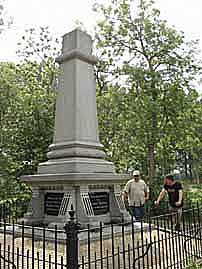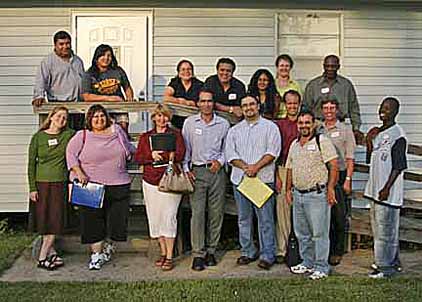Canadian Mennonite
Volume 10, No. 18
September 18, 2006

Dutch Mennonites plan international centre
Witmarsum, Netherlands
 |
The ancient writer of Ecclesiastes observed that there is “a time to be born and a time to die.” Dutch Mennonites know these cycles well. Dying Dutch Anabaptists birthed a new, living church in the 16th century. Today, a struggling Dutch church seeks new life by inviting global Anabaptists to join it in remembering the past and anticipating the future.
Nearly five centuries after Sicke Freerks testified of his faith in Christ and offered his neck to the executioner’s sword—an act that caught the attention of a Catholic priest named Menno Simons—the faith descendents of these martyrs in Friesland and elsewhere in the Netherlands dream of new life. A committee developing the International Menno Simons Center aims to tell the world this 500-year-old story. Planners hope to invite global Anabaptists and others to come and enrich each other by sharing their faith stories.
Initial plans describe a destination for global Anabaptists and other interested individuals featuring food, fellowship, inspiration and education. Planners identify Witmarsum as a preferred location for the centre. An 1878 marker on the outskirts of Witmarsum offers a starting point. The stone monument marks the location of a Mennonite meeting place, beginning in the 16th century. In addition to the marker, Witmarsum was also the birthplace of Menno Simons. Further, Menno Simons left the Catholic priesthood at the Witmarsum church to join the Anabaptists in 1536.
The precise nature of the centre remains in formation. One plan offers space for small groups of global Anabaptists to study, worship and collectively seek routes to a viable future. International volunteer teams, assembled through existing church organizations, could provide staff. A museum and archives, likely including a quilt display currently travelling in North America, would provide historical grounding. Early discussions include consideration of an electronic database for visual art collections describing Mennonite life. Eventually, the Dutch hope to invite international financial support for this project.
This bold move by the Dutch Mennonites to blend together a deep, rich heritage with a contemporary and varied global Anabaptist witness prompts scepticism among some observers. Some wonder whether the church could use the financial resources needed by the centre in more beneficial ways. Others question the relevance of the 16th century experience for 21st century Christians.
Nonetheless, Dutch Mennonites, encouraged by international Anabaptist opinion, welcome the prospect of a new work. They anticipate a fresh look at the past and a lively hope for the future can revitalize Menno Simons’ teaching that “no one can lay any foundation other than the one that has been laid; that foundation is Jesus Christ” (I Corinthians 3:11 NRSV).
‘Time to deliver’ on AIDS promises
Toronto
 |
More than 25,000 people gathered in Toronto last month for the 16th International AIDS Conference. The conference, held every two years, is the world’s largest gathering of people working on HIV/AIDS issues.
During the week prior to the main conference, a two-day ecumenical pre-conference was held. Christians from around the world gathered to share ideas and encourage each other in the struggle against AIDS. Special speakers included Canon Gideon Byamugisha, the first African priest to openly share his HIV status; pastor Rick Warren, author of The Purpose Driven Life; and Peter Piot, executive director of UNAIDS.
As part of the ecumenical conference, Mennonite Central Committee (MCC) presented a workshop on the role of pastors and church leaders in the AIDS pandemic. Workshop participants from around the world shared stories about their struggles to involve pastors in the fight against AIDS and then shared strategies for addressing these challenges.
Why am I here?
|
The official opening of the 16th International AIDS Conference included Canadian government officials, business leaders, actors and musicians. As the week began, workshops and plenary sessions included input from Bill Gates, Bill Clinton, Canadian Stephen Lewis, and Pretty Woman actor Richard Gere.
The theme for this year’s conference was “Time to deliver.” The time for the global community to deliver on its promises is now. The crisis requires action now. Lewis, the UN Special Envoy for AIDS in Africa, put it very simply, “Every minute lost in the struggle against the virus is a life lost.” Actually, every minute lost is more than five lives lost and nine new lives infected. AIDS is an ongoing emergency, a chronic tragedy that continues to kill 8,500 people each day.
The conference included no lack of learning opportunities. The program of activities was 487 pages long. At any given time, there were 25 different sessions to choose from, as well as exhibitions, video showings and demonstrations.
While all are still under trial, there emerged three potential new means of reducing the spread of the virus.
The first is a microbicide, a vaginal gel or cream that a woman can apply to reduce HIV transmission during sexual intercourse. Even a woman who has been faithful in marriage and who fully understands the risk of HIV infection can lack the power to require her husband to use a condom. If the development of microbicides proves successful, it will put the power of HIV protection in women’s hands.
Another potential means of reducing HIV transmission is through male circumcision. Initial studies in South Africa and Kenya have shown significantly reduced rates of HIV infection among men who were circumcised.
Pre-exposure prophylaxes were a third idea introduced. For years, post-exposure prophylaxes have been used to successfully reduce HIV transmission in cases such as rape or exposure to the virus in a medical setting. New research is showing the potential for these types of drugs prior to exposure for people that may be at high risk of contracting HIV. The concept is similar to that of taking a malarial prophylactic while visiting a malarial zone.
Along with hopeful new research and solutions came a recognition of barriers that have stopped the world from successfully addressing the AIDS crisis. The role poverty plays in the global crisis was a common theme. All over the world, global economic systems force men to leave their families for months at a time and work as migrant labourers in areas far from home.
Women, dependent solely on men for their income and survival in many places, are forced into situations where their health and wellbeing are compromised.
Many people, especially those sick because of AIDS, lack the ability to feed themselves properly. Food insecurity is a major reason AIDS continues to make people so sick, and without sufficient food even those on life-prolonging anti-retroviral medication are not able to receive the full benefit of the drugs.
Marginalized groups were also vocal about the often hidden epidemic in North America. The U.S.-based Black AIDS Institute hosted discussions and marches highlighting the need to do more to address HIV/AIDS in the black community in the United States. African-American women accounted for 67 percent of all new infections in the U.S. in 2004.
Aboriginal groups from Canada were also vocal about the AIDS crisis among First Nations people, where infection rates have increased by 500 percent over the last 20 years, while the national Canadian average has decreased by 24 percent in the same time period.
As the week came to a close, organ-izers and participants called on governments, drug companies, churches, foundations, research institutions and individuals to act immediately to prevent the further spread of the disease. Only through a timely, significant and coordinated effort will progress be realized in the fight against AIDS.
Massive destruction greets MCC assessment team
Beirut, Lebanon
 |
A Mennonite Central Committee (MCC) assessment team observed massive destruction in Beirut and southern Lebanon while visiting communities affected by the recent war between the Israeli army and Hezbollah militants.
The five-person team is planning MCC’s ongoing aid response in Lebanon, where the war destroyed thousands of homes, displaced nearly a million people and caused about 1,300 deaths. MCC has already committed $187,000, including $45,600 to provide emergency assistance to people who were fleeing the fighting.
After arriving in Lebanon on Aug. 25, the team visited a southern area of Beirut that was devastated by Israeli air strikes. Ten-storey apartment buildings were reduced to piles of concrete rubble. Areas as large as half a city block were levelled. Many of the buildings that still stood were heavily damaged.
Most residents fled southern Beirut during the war. Some left the city, stayed with relatives or rented an apartment in safer areas. Others filled Beirut’s parks and schools by the thousands.
Helping Lebanese children
|
For Mary Mikhael, president of the Near East School of Theology, the crisis brought back painful memories of Lebanon’s 17-year civil war, which ended in 1991. “It shocked me to the depths of my being,” Mikhael said. “It brought it all back.”
The theology school was used as a relief centre throughout the civil war, and during the recent war it became one again. Each day, volunteers packed about 1,000 boxes of food and 1,000 boxes of soap, candles and other basic items, and distributed them to displaced people.
The Middle East Council of Churches carried out this relief with a grant of $11,000 from MCC. Both are MCC partner organizations.
In the southern Lebanese city of Sidon, the assessment team met with Mayor Abdul Rahman Bizri and with staff members of the Development for People and Nature Association, a partner organization that provided food and other assistance to thousands of displaced people during the war.
Sidon, a city of about 250,000, received more than 110,000 displaced people during the war. Many stayed in schools and other public buildings.
Thuraya Al-Bouz, a relief worker with the Development for People and Nature Association, organized children’s activities at a school building where displaced families were staying.
“The most important for me was the drawing, because the child can reflect what all is going on in his mind,” Al-Bouz said.
Farther south, the assessment team visited Qlayleh, a village of 6,000 near the Mediterranean coast. Israeli air strikes destroyed about 200 houses in the village and severely damaged another 150. Eight people were killed and most fled north for the duration of the war.
Ahmad Sheble, a 74-year-old orange grower, fled Qlayleh with his wife, two adult children and 95-year-old mother on the second day of the conflict. They fled first to the nearby city of Tyre, then to Beirut—and when bombs fell too close to them in Beirut, they went into the mountains of eastern Lebanon. There, they rented an apartment at a rate of more than $100 per day.
“Thank God the [UN] Security Council made the ceasefire happen that day,” Sheble said. “We couldn’t afford to stay for another day. We could barely afford to get back.”
Upon his return, Sheble found that bombs destroyed about a quarter of his orange trees and his irrigation system.
“I pray to God,” Sheble said. “This is what we want—to live in peace.”
Hurricane Katrina a year later
U.S. Gulf Coast
 |
From New Orleans west to Houston, and northeast to Meridian, Miss., Mennonite organizations continue their multi-million-dollar response to Hurricane Katrina.
On the first anniversary of the storm—which swept ashore on Aug. 29, 2005, causing unimaginable flooding in New Orleans and wreaking devastation throughout the U.S. Gulf Coast—Mennonite Central Committee (MCC) hurricane response workers say needs remain strong even as new outreaches develop.
“People are hurting so much, it’s incredible,” said Blanca Mackay, a hurricane response worker serving with her Anabaptist congregation, Amor Viviente, in Metairie, La. “But every little thing that you can do, it helps. It brings relief to people. The most important thing, when people hear that people care, that makes a difference.”
More than a half-million dollars has been spent by MCC so far on immediate assistance after the storm, outreaches to evacuees and support of local workers in storm-affected areas. Over the next two to three years, MCC will support long-term projects to participate with evacuees in their recovery and to work in collaboration with local churches and organizations in affected areas.
Mennonite Disaster Service (MDS) and MCC continue as partners in this effort, with MDS providing teams to rebuild homes while MCC supports local projects and workers, provides case management and works at underlying injustices, such as poverty, inequality and racism, that the storm brought to the surface.
In addition to the more than $2 million in donated funds, MCC has also provided nearly $1 million worth of material aid.
Canadians volunteer with MDS
More than 4,000 volunteers, 783 of them from Canada, have served with MDS in the Gulf Coast over the past year. The first Canadian on the scene was Jerry Klassen, an experienced MDS project director who has worked in the aftermath of hurricanes in the past. Klassen was subsequently named as the MDS Gulf Coast coordinator, putting in place the infrastructure needed for successful work projects in areas affected by Katrina and the subsequent Hurricane Rita.
Eighty community projects have been opened in the Gulf Coast by MDS, totalling 919 individual jobs, mostly home cleanups and repairs.
In an unprecedented move, MDS purchased land in Pass Christian, Miss., and built a camp using mobile homes to accommodate up to 70 volunteers at a time.
MDS has started new programs to accommodate retired people with mobile homes. Under the new RV program, older participants are able to bring their own accommodations to the MDS Gulf Coast sites and work shorter hours.
Other recent developments include the purchase of a building in New Orleans, not far from the infamous Ninth Ward, which will be used to accommodate up to 40 volunteers at a time and serve as office space.
MDS partners with MEDA
Mennonite Economic Development Associates (MEDA) and MDS are partnering in a new Back to Business initiative. The goal of Back to Business advisor Adele London is to revitalize the business core of six struggling neighbourhoods by helping existing business owners get back on their feet and assisting prospective entrepreneurs who are starting a business.
London recently held her first training classes for a dozen fledgling entrepreneurs, most of them African-American women who want to start home-based companies selling nutritional supplements or online hair care products.
Personal stories
Some members of Amor Viviente are living in renovated housing but are still suffering the financial repercussions of evacuation and missed pay cheques. Others are still living in government-supplied trailers. Some are just beginning to rebuild.
In one instance, MDS was able to clear one member’s house and clean mould from it, protecting it from further deterioration. But rebuilding stalled for months as the homeowner, assisted by Mackay, sorted through insurance, the Federal Emergency Management Agency (FEMA) and who would pay for further repairs.
This summer, Amor Viviente had four MCC U.S. Summer Service workers who organized a group of volunteers from Minnesota to do repairs for church members. MCC school kits are being given to students returning to school in Louisiana this fall.
The congregation continues to provide items, including MCC meat, to people in the community who are in need. “We have accomplished a lot,” Mackay said.
In Houston, where some 150,000 evacuees continue to live, a local hurricane response team has begun to do case management to help evacuees, many of them Spanish-speaking, to become self-sufficient again.
Many people are still emotionally distraught. Case manager Nancy González has noticed the transition seems particularly hard on youths aged nine to 15. “They want to be back in their own home with their own things,” she said. “They’re still doing without a lot of what they used to have in Louisiana.”
In working with one family who needed to complete FEMA paperwork, González learned their 14-year-old daughter had made the cheerleading squad and basketball team at her new school, but the family could not afford the physical exam required for her to participate in extracurricular activities. MCC paid for a physical and for shoes, while the school coach funded a cheerleading outfit.
In Meridian, MCC supports Lydia Weikel, who moved from Pennsylvania to work with Rebuild East Mississippi. “The needs are really still so very, very great. I know in the North, they don’t hear so much anymore,” Weikel said. “They assume everything’s back to normal. And it’s really so very, very far from normal.”
—From MCC, MDS and MEDA releases